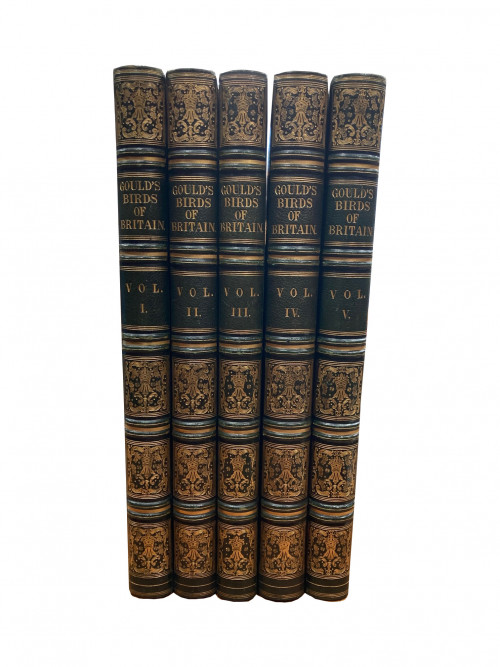- HOME
-
- Latest Arrivals
- View All Items
- Ancient History
- Art, Architecture and Design
- Auto/Biography
- Childrens and Illustrated
- Classics
- Colour Plate
- Economics
- Eighteenth Century
- Ephemera
- Fantasy and Science Fiction
- Fine Bindings
- Library Sets
- Literature
- Medieval History
- Military
- Modern Firsts
- Modern History
- Natural History
- Philosophy
- Poetry
- Politics
- Private Press
- Provincial Binding and Printing
- Reference
- Religion
- Seventeenth Century
- Signed
- Sport
- Topography
- Transport
- Travel
- Unspecified
- Winston Churchill
-
SOLD ITEMS
- Temple Book Binders
- About
- Contact
- Home
- Ancient History
- Description De l'Egypt
Description De l'Egypt
Description De l'Egypt
1461
21 vols bound in 20 (9 volumes quarto text, 1 volume elephant folio text [bound with Antiquities vol I], 11 elephant folio plate volumes), the complete set of 894 plates of which 40 are wholly or partly printed in colours and or hand-coloured, and 2 printed in bistre, many double-page, and or, folding, plate DD in Etat Moderne II with fore-margin sometime renewed, scattered light foxing, contemporary calf gilt with marbled paper panels to covers (moiré cloth panels to natural history vols.), text volumes
rebacked to style, spine gilt lettered and ruled, 1809-1830. ANTIQUITIES - 5 vols: (I) Engraved frontispiece, map, 99 plates numbered 1-97 (plates 79 and 87 each in two states) + 1 unnumbered plate; Bound with folio text; (II). 92 plates numbered 1-92; (III). 69 plates numbered 1-69 ; (IV). 72 plates numbered 1-72 + 2 plates lettered e & f ; (V). 89 plates numbered 1-89. ETAT MODERNE - 2 vols. (I). Engraved map, 83 plates numbered 1-83; (II). 22plates numbered 84-105 + 31 plates numbered I-XXXI + 11 plates lettered A-K + 9 plates lettered AA-II + 4 plates lettered KK-NN + 9 plates lettered a-i + 1 plate lettered k (JJ and j not used). HISTOIRE NATURELLE - 2 vols bound in 3: (I). 62 plates; (II). 105 plates; (II bis). 77 plates. Amongst the artists who contributed to this section are Barraband, Bessa, Redoute, and Turpin. CARTES GEORAPHIQUE ET TOPOGRAPHIQUE - engraved title & 52 engraved plates. Provenance: Bookplate of Algernon Percy, 4th Duke of Northumberland (1792-1865). Volumes with either the Garter Crest or Ducal bookplate. Percy, the second son of Hugh, the second Duke, was a distinguished naval officer and a man of science and learning, who rose to the rank of Admiral, and was First Lord of the Admiralty in 1852. Percy became Duke of Northumberland in 1847, and a Knight of the Garter in 1852. FIRST EDITION OF ONE OF THE MOST AMBITIOUS SCIENTIFIC, HISTORICAL, ARTISTIC AND PUBLISHING PROJECTS - A COMPLETE SET WITH FINE ENGLISH PROVENANCE. THE FIRST COMPREHENSIVE DESCRIPTION OF ANCIENT AND MODERN EGYPT, THE OUTSTANDING ACHIEVEMENT OF THE SAVANTS WHO ACCOMPANIED NAPOLEON'S EXPEDITION TO EGYPT (1798-1801). THE WORK IS THE GREATEST OF A NUMBER OF OUTSTANDING SCIENTIFIC PUBLICATIONS BY THE FRENCH GOVERNMENT DETAILING THE RESULTS OF EXPLORATION, UNEQUALLED BY ANY OTHER NATION DURING THE SAME PERIOD. The only flaw in Napoleon’s preparations for the invasion of Egypt was a miscalculation when it came to Turkey’s reaction to France’s unsolicited ‘help’ in dealing with its mostly unruly vassals, the Mamluks of Egypt. Had it not been for this, Napoleon’s plan for following up military conquest by revolutionising the economy and institutions of Egypt might well have created a modern European-style state, controlled by France, at the axis of
all the trade routes between Europe, India and the East. Plans to this end involved nearly 500 civilians, the cream of whom were about 150 men drawn from the Institut de France. Once in Egypt their first task was to make a thorough survey of every aspect of the country to assist the planning of its future shape, and this was extended to include Antiquities. The work was co-ordinated by L’Institut de l’Egypte (later replaced by the Commission des Sciences et Arts d'Egypte), founded in the appropriated house of Hassan Kachef (illustrated in the plates to the Etat Moderne), with Gaspar Monge as president.As early as October 1798 Fourier was entrusted with the task of uniting the
reports of the various disciplines with a view to publication. Following the capitulation of the army to Egypt under General Menou (a convert to Islam), the savants returned to France where a commission was set up for the editing and supervision of the work. The first volumes were published by
Napoleon’s government, and it is a measure of how important this work was considered to be that publication continued following the Bourbon restoration. ‘... never before or since has a study of such scope and thoroughness been accomplished on the basis of field work carried out in so short a space of time and under such inadequate and harrowing circumstances’ (J.C. Herold, Bonaparte in Egypt, 1963). Antiquities describes not only the ruins, but also the objects excavated, including the Rosetta Stone, here described for the first time. The quality of the plates was much enhanced by the use of an engraving machine invented by Conte, which is itself illustrated among the plates. Etat Moderne describes the architecture of Egypt subsequent to the Arab invasion in the seventh century, particularly Cairo, as well as sections on Art et Métiers, Costumes et Portraits, Vases, Meubles et Instruments, and Inscriptions, Monnaies et Médailles. Atabey, 343; Blackmer, 476; Brunet II, 616-617; Nebenzahl, Maps of the Holy Land, 60; Nissen, BBI, 2234; Nissen, ZBI, 4608; Wilbour pp178-185
1809-1830
Thank you for your enquiry.
We will get back to you soon.
Please create wishlist to add this item to
RELATED ITEMS
































